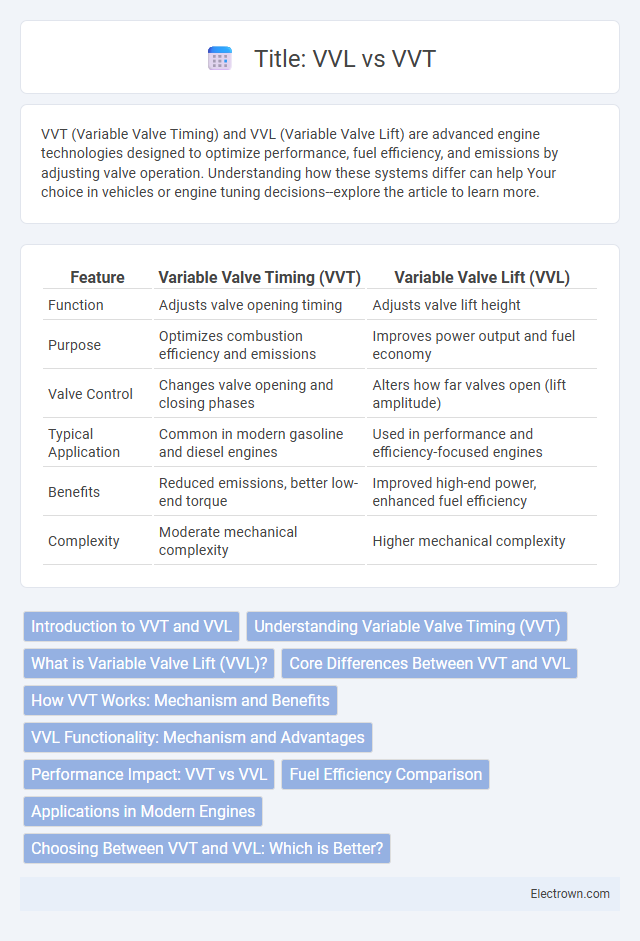VVT (Variable Valve Timing) and VVL (Variable Valve Lift) are advanced engine technologies designed to optimize performance, fuel efficiency, and emissions by adjusting valve operation. Understanding how these systems differ can help Your choice in vehicles or engine tuning decisions--explore the article to learn more.
Table of Comparison
| Feature | Variable Valve Timing (VVT) | Variable Valve Lift (VVL) |
|---|---|---|
| Function | Adjusts valve opening timing | Adjusts valve lift height |
| Purpose | Optimizes combustion efficiency and emissions | Improves power output and fuel economy |
| Valve Control | Changes valve opening and closing phases | Alters how far valves open (lift amplitude) |
| Typical Application | Common in modern gasoline and diesel engines | Used in performance and efficiency-focused engines |
| Benefits | Reduced emissions, better low-end torque | Improved high-end power, enhanced fuel efficiency |
| Complexity | Moderate mechanical complexity | Higher mechanical complexity |
Introduction to VVT and VVL
Variable Valve Timing (VVT) and Variable Valve Lift (VVL) are advanced engine technologies designed to optimize engine performance, fuel efficiency, and emissions control by dynamically adjusting valve timing and valve lift, respectively. VVT primarily modifies the timing of valve opening and closing based on engine speed and load, improving torque and power delivery across different RPM ranges. VVL further enhances engine efficiency by altering the valve lift height, enabling precise control over air-fuel mixture and combustion for improved performance and reduced fuel consumption.
Understanding Variable Valve Timing (VVT)
Variable Valve Timing (VVT) technology enhances engine performance by adjusting the timing of valve opening and closing based on driving conditions. VVT improves fuel efficiency, increases power output, and reduces emissions by optimizing airflow and combustion. Understanding VVT helps you appreciate how modern engines balance performance and environmental standards effectively.
What is Variable Valve Lift (VVL)?
Variable Valve Lift (VVL) technology adjusts the height that engine valves open, optimizing air intake and exhaust flow based on engine speed and load. By varying valve lift, VVL enhances combustion efficiency, resulting in improved fuel economy, increased power output, and reduced emissions. This system works in tandem with Variable Valve Timing (VVT), but while VVT adjusts valve timing, VVL specifically controls the valve lift for better engine performance.
Core Differences Between VVT and VVL
Variable Valve Timing (VVT) adjusts the timing of the valve opening and closing to optimize engine performance and fuel efficiency, while Variable Valve Lift (VVL) changes the extent to which the valves open, allowing for enhanced power output and reduced emissions. VVT primarily modifies the camshaft phase angle for timing variation, whereas VVL alters the valve lift through different cam profiles or mechanisms to adjust valve height. Your engine benefits from VVT's improved torque at various RPMs, while VVL offers greater control over valve operation to maximize efficiency and power.
How VVT Works: Mechanism and Benefits
Variable Valve Timing (VVT) adjusts the timing of valve opening and closing by changing the camshaft position relative to the crankshaft using hydraulic or electronic actuators, optimizing engine performance across different RPM ranges. This mechanism enhances fuel efficiency, reduces emissions, and improves power output by ensuring valves open at the ideal moments for combustion. Your engine benefits from smoother acceleration and better overall responsiveness with VVT technology.
VVL Functionality: Mechanism and Advantages
Variable Valve Lift (VVL) adjusts the height of the valve opening to optimize engine performance and efficiency, allowing for improved fuel economy and increased power output. The mechanism uses hydraulic or mechanical systems to alter the lift profile based on engine speed and load conditions, enhancing airflow and combustion precision. Your engine benefits from smoother operation, reduced emissions, and enhanced responsiveness through the dynamic control of valve lift.
Performance Impact: VVT vs VVL
Variable Valve Timing (VVT) improves engine efficiency by adjusting the timing of valve opening and closing, enhancing torque and fuel economy across different RPM ranges. Variable Valve Lift (VVL) further optimizes engine performance by altering the valve lift height, increasing airflow and power output at high engine speeds while maintaining smooth operation at low speeds. Your vehicle benefits from VVL's ability to maximize both power and efficiency over VVT by offering more precise control of valve operation.
Fuel Efficiency Comparison
Variable Valve Timing (VVT) and Variable Valve Lift (VVL) both improve fuel efficiency by optimizing engine performance based on driving conditions. VVT adjusts the timing of valve operation to enhance fuel combustion, resulting in better mileage and reduced emissions. VVL further refines efficiency by varying the valve lift, allowing your engine to maximize fuel economy and power output more precisely under different loads.
Applications in Modern Engines
Variable Valve Timing (VVT) and Variable Valve Lift (VVL) are critical technologies enhancing combustion efficiency and performance in modern engines. VVT adjusts valve timing to optimize power and fuel economy across different RPM ranges, widely implemented in both naturally aspirated and turbocharged gasoline engines. VVL, offering precise control over valve lift, is primarily used in performance-oriented engines to improve air intake and volumetric efficiency, contributing to increased horsepower and reduced emissions.
Choosing Between VVT and VVL: Which is Better?
Choosing between Variable Valve Timing (VVT) and Variable Valve Lift (VVL) depends on your vehicle's performance needs and fuel efficiency priorities. VVT optimizes valve timing for better torque and fuel economy across RPM ranges, while VVL enhances engine power by varying valve lift, improving airflow at higher speeds. Your choice should align with whether you prioritize improved fuel efficiency and smoother driving (VVT) or increased engine performance and responsiveness (VVL).
VVT vs VVL Infographic

 electrown.com
electrown.com